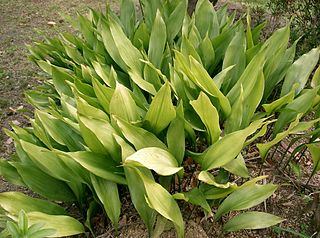
Aspidistra is a genus of flowering plants in the family Asparagaceae, subfamily Nolinoideae, native to eastern and southeastern Asia, particularly China and Vietnam. They grow in shade under trees and shrubs. Their leaves arise more or less directly from ground level, where their flowers also appear. The number of species known has increased considerably from the 1980s onwards, with around 100 accepted as of July 2013. Aspidistra elatior is common worldwide as a foliage house plant that is very tolerant of neglect. It and other species can also be grown in shade outside, where they are generally hardy to −5 °C (23 °F).

Caridina is a genus of freshwater atyid shrimp. They are widely found in tropical or subtropical water in Asia, Oceania and Africa. They are filter-feeders and omnivorous scavengers. They range from 0.9–9.8 mm to 1.2–7.4 mm in carapace length.

Coprinellus is a genus of mushroom-forming fungi in the family Psathyrellaceae. The genus was circumscribed by Petter Karsten in 1879. Most Coprinellus species were transferred from the once large genus Coprinus. Molecular studies published in 2001 redistributed Coprinus species to Psathyrella, or the segregate genera Coprinopsis and Coprinellus.

Parasola is a genus of coprinoid mushrooms in the family Psathyrellaceae. These small frail fungi have translucent caps where the radiating gills look like the spokes of a parasol. In the past these mushrooms were classified under Coprinus, but unlike that genus there is no veil and the caps do not really turn to ink, but curl up and wither.

Triplophysa is a genus of fish in the family Nemacheilidae found mainly in and around the Qinghai-Tibet Plateau in China. Currently, the genus is a mixed assemblage of species. Some lineages have been identified and treated as subgenera, but as Wikipedia follows Fishbase for fish species all but Hedinichthys have been treated as subgenera in Wikipedia, although Kottelat in his revision of the loaches did recognise them as valid. FishBase, however, includes these in Triplophysa without specifying subgenera and treats the names given by Kottelat as synonyms.

Homeobox protein Hox-B13 is a protein that in humans is encoded by the HOXB13 gene.

Corin, also called atrial natriuretic peptide-converting enzyme, is a protein that in humans is encoded by the CORIN gene.

Aspicilia is a genus of mostly crustose areolate lichens that grow on rock. Most members have black apothecia discs that are slightly immersed in the areolas, hence the common name.
In molecular biology mir-365 microRNA is a short RNA molecule. MicroRNAs function to regulate the expression levels of other genes by several mechanisms.

Circinaria is a genus of crustose lichens in the family Megasporaceae. It was circumscribed by Johann Heinrich Friedrich Link in 1809.
Quantum image processing (QIMP) is using quantum computing or quantum information processing to create and work with quantum images.
Bat coronavirus RaTG13 is a SARS-like betacoronavirus that infects the horseshoe bat Rhinolophus affinis. It was discovered in 2013 in bat droppings from a mining cave near the town of Tongguan in Mojiang county in Yunnan, China. In February 2020, it was identified as the closest known relative of SARS-CoV-2, the virus that causes COVID-19, sharing 96.1% nucleotide similarity. However, in 2022, scientists found three closer matches in bats found 530 km south, in Feuang, Laos, designated as BANAL-52, BANAL-103 and BANAL-236.

ML-SI3 is a chemical compound which acts as an "antagonist" of the TRPML family of calcium channels, with greatest activity at the TRPML1 channel, although it also blocks the related TRPML2 and TRPML3 channels with lower affinity. It is used for research into the role of TRPML1 and its various functions in lysosomes and elsewhere in the body.
RacCS203 is a bat-derived strain of severe acute respiratory syndrome–related coronavirus collected in acuminate horseshoe bats from sites in Thailand and sequenced by Lin-Fa Wang. It has 91.5% sequence similarity to SARS-CoV-2 and is most related to the RmYN02 strain. Its spike protein is closely related to RmYN02's spike, both highly divergent from SARS-CoV-2's spike.
Kauffmania is a monotypic genus of fungi belonging to the family Psathyrellaceae. The only species is Kauffmania larga.
Homophron is a genus of fungi belonging to the family Psathyrellaceae.
Bat coronavirus RpYN06 is a SARS-like betacoronavirus that infects the horseshoe bat Rhinolophus pusillus, it is a close relative of SARS-CoV-2 with a 94.48% sequence identity.










